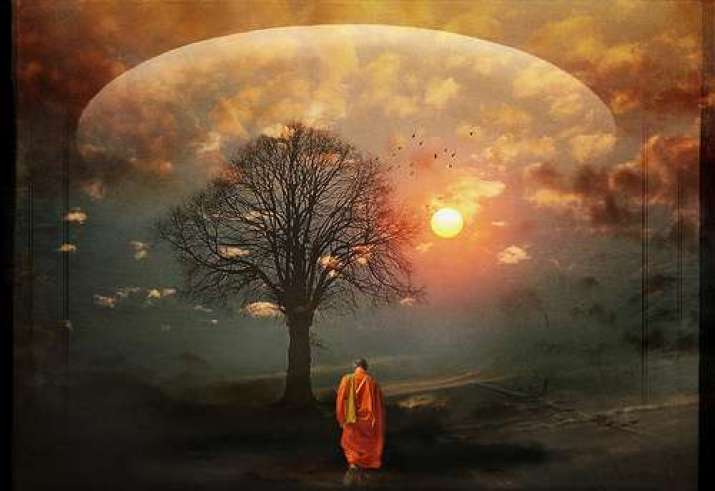
A lot of meditators and practitioners have difficulty understanding the term sankhara, especially when it is translated from the original Pali into English as formations or volitional formations.
Such terms may indeed befuddle an occidental student of epistemology who conceptualizes being and form in a Platonic ideal, permanent, metaphysical sense, but who does not as yet understand becoming as a process of continual, impermanent flux, arising and ceasing, arising and ceasing, in the causal Buddhadhamma sense.
To pinpoint the paradox more exactly:
- On the one hand, as seen in a Greek philosophical sense, form is a metaphysically fixed, finite or infinite form as an absolute and permanently abiding thing.
- On the other hand, according to the Buddhadhamma sense, formation is perceived as a process of dependently arising, impermanently appearing phenomena, flowing in a continuum and disappearing as the process is ultimately ceasing.
Phenomena may either be absolute entities or changing appearances in a continuum relative to one another. They cannot be both at the same time. While this may still be unclear to some, at least we have put our finger on the epistemological problem.
What is perplexing about so-called reality is that, in a phenomenological sense, things may indeed not be what they appear to be. An illustration that may help us to better understand the arising formations of sankhara is contained in the following explication by Danister I. Fernando:
Sankhara—conditioned phenomenon
How pretty is a flower in bloom! Yet, it fades away and meets with destruction in no time! Why is that so? It is because the flower is a sankhara—a conditioned phenomenon. According to Buddha-word, Sabbe sankhara anicca, All conditioned phenomena are subject to constant change. Let us see.
The term sankhara, according to its context, has different shades of meaning. In this essay, I have decided to use this term as it occurs in the sense of anything compounded and conditioned, and includes all things whatever in the world, nay, in the universe, all phenomena of existence.
All things that arise on account of “causes” are said to be conditioned phenomena or sankhara. To find out what these “causes” are let us first take the simple example of a mango tree. The modern belief is that plants have life. Buddha also has said that those with life belong to three categories—human beings, animals and plants; but, plants do not have a mind (vinnana). Therefore I shall take this example of a mango plant as something with life but without vinnana.
A mango plant, to grow up, requires a seed and a host of other requirements. If the seed is kept on a dry surface it’ll never grow. It has to be planted along with the other requirements. So then, the main “cause” (hetu) for the plant to come up is the seed. The contributory causes (pratya)—attached to it are soil, water, sunshine, etc. Since the mango plant grows because of “causes” or conditions, it is a conditioned phenomenon—a sankhara.
Let us now take the case of a human being, a man. How has he come into being? That also occurs on account of “causes.” Buddhist psychology speaks of vinnana (consciousness) as that which plants itself in the womb of a mother.
The vinnana or citta which passes from one existence to the next is called patisandhi vinnana or patisandhi citta. This term means “The again-linking-up” consciousness, that ever and again supplies the bond between one existence and another.
At this juncture, it has to be clearly understood that the very same consciousness does not come to the new birth from the previous one. It is only to causes contained in the previous existence that its new appearance is due.
This is sometimes called “rebirth,” but one must be careful when using the term “rebirth.” Consciousness continuing in a new formation does not imply the rebirth of a “person” or “self” but only a continuum or a relinking-consciousness as mere mind mental energy changing or moving from a particular set of aggregates and moving into another relative causal, dependent and impermanent form.
Buddhism does not make any acceptance to a permanent “soul” (atta)—definitely not. The concept of soul is only a mental perception. What really happens is that accumulation of kamma, wholesome, and unwholesome collected during samsara forms an energy which becomes the potential for a new birth.
Therefore for a man to be born the patisandhi vinnana becomes the main cause. The contributory causes are parents’ contribution, the mother’s womb, the necessary nutrients, etc. Under these causes a being conceives. So the man is a conditioned phenomenon—a sankhara.
Similarly, the conditioned nature is common to each and everything [every phenomena] in this Universe, and all are subject to change, decay and destruction in flux. The mind (nama) too is conditioned because it also rises owing to causes. We should understand that there is no body organ which can be identified as mind. There are merely a number of states of mind in very rapid succession. We should understand that both body and mind (rupa and nama) are conditioned phenomena. In the ultimate sense, there exist only ever-changing physical and mental phenomena.
The causes (hetu) themselves, which bring about effects (phala) also cease to exist. Then simultaneously, [the] effects too cease to exist. This fact is stated in the Dhamma thus:
“Hetun paticca sambhutan Hetu bhanga nirujjhati”
One loses a loved-one all of a sudden. What befell the loved-one is this very same thing, a thing that befalls all conditioned phenomenon. That person was born of conditions. He lived because of conditions and he passed away also due to the same reason. This is the nature of sankhara—conditioned phenomena.
This happens not only to that loved one. I, who am writing this essay, and you who are reading it and all others existing in this Universe, will definitely have to face this situation. So, really speaking one should not lament over a death, since it is only a general law. Buddha has said, “Sabbe satta marissanti,” All beings die. It is greed (lobha) and delusion (moha) that are responsible for lamentation.
But, however, The Blessed One has declared that there is one only Dhamma which is unformed and unconditioned (asankhata dhatu) and that is nibbana—the only reality. The unconditioned state of ultimate release.”
Such language from a Theravada scholar may sound strange to a Western Platonist who believes in the theory of forms and who has not yet become accustomed to the Buddhadhamma way of thinking.
However, if such an occidental philosopher re-reads this essay and thinks his way through the step-by-step explication, he may come to realize that being and form are not rigidly fixed and that knowing how all conditioned phenomena are in a process of becoming and ceasing can actually ease the mind into an eventual sense of relief and release.
See more
‘Sankhara’ – conditioned phenomenon (Buddhi Vihara)














